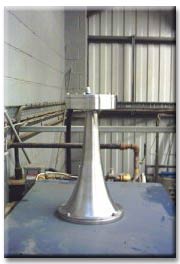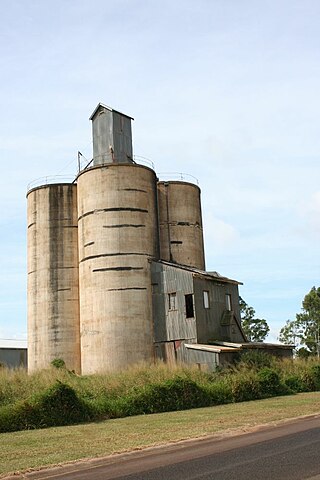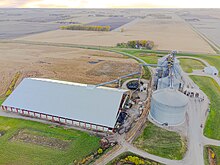
Silage is a type of fodder made from green foliage crops which have been preserved by fermentation to the point of acidification. It can be fed to cattle, sheep, and other such ruminants. The fermentation and storage process is called ensilage, ensiling, or silaging. Silage is usually made from grass crops, including maize, sorghum, or other cereals, using the entire green plant.

A grain elevator is a facility designed to stockpile or store grain. In the grain trade, the term "grain elevator" also describes a tower containing a bucket elevator or a pneumatic conveyor, which scoops up grain from a lower level and deposits it in a silo or other storage facility.

Bulk material handling is an engineering field that is centered on the design of equipment used for the handling of dry materials. Bulk materials are those dry materials which are powdery, granular or lumpy in nature, and are stored in heaps. Examples of bulk materials are minerals, ores, coal, cereals, woodchips, sand, gravel, clay, cement, ash, salt, chemicals, grain, sugar, flour and stone in loose bulk form. It can also relate to the handling of mixed wastes. Bulk material handling is an essential part of all industries that process bulk ingredients, including: food, beverage, confectionery, pet food, animal feed, tobacco, chemical, agricultural, polymer, plastic, rubber, ceramic, electronics, metals, minerals, paint, paper, textiles and more.

Kid Spark Education is a nonprofit organization that develops and produces affordable Mobile STEM Labs and curriculum for Schools and Youth Service Organizations. The Rokenbok Toy Company was founded in 1995 by Paul Eichen in the United States to create an heirloom quality toy system. The first Rokenbok toys debuted at the 1997 American International Toy Fair in New York City. In 2010 the company made a substantial push researching the effect of media, like Rokenbok, on developing minds. In 2015 the company transitioned into a 501(c)(3) and completed the development of their first 4 classroom specific products called Mobile STEM Labs. Since then, Kid Spark Education has placed Mobile STEM Labs in over 22 states across the country.

A granary is a storehouse or room in a barn for threshed grain or animal feed. Ancient or primitive granaries are most often made of pottery. Granaries are often built above the ground to keep the stored food away from mice and other animals and from floods.

A silo is a structure for storing bulk materials. Silos are used in agriculture to store fermented feed known as silage, not to be confused with a grain bin, which is used to store grains. Silos are commonly used for bulk storage of grain, coal, cement, carbon black, woodchips, food products and sawdust. Three types of silos are in widespread use today: tower silos, bunker silos, and bag silos.

Acoustic cleaning is a maintenance method used in material-handling and storage systems that handle bulk granular or particulate materials, such as grain elevators, to remove the buildup of material on surfaces. An acoustic cleaning apparatus, usually built into the material-handling equipment, works by generating powerful sound waves which shake particulates loose from surfaces, reducing the need for manual cleaning.
For environmental remediation, Low-temperature thermal desorption (LTTD), also known as low-temperature thermal volatilization, thermal stripping, and soil roasting, is an ex-situ remedial technology that uses heat to physically separate petroleum hydrocarbons from excavated soils. Thermal desorbers are designed to heat soils to temperatures sufficient to cause constituents to volatilize and desorb from the soil. Although they are not designed to decompose organic constituents, thermal desorbers can, depending upon the specific organics present and the temperature of the desorber system, cause some organic constituents to completely or partially decompose. The vaporized hydrocarbons are generally treated in a secondary treatment unit prior to discharge to the atmosphere. Afterburners and oxidizers destroy the organic constituents. Condensers and carbon adsorption units trap organic compounds for subsequent treatment or disposal.

A concrete plant, also known as a batch plant or batching plant or a concrete batching plant, is equipment that combines various ingredients to form concrete. Some of these inputs include water, air, admixtures, sand, aggregate, fly ash, silica fume, slag, and cement. A concrete plant can have a variety of parts and accessories, including: mixers, cement batchers, aggregate batchers, conveyors, radial stackers, aggregate bins, cement bins, heaters, chillers, cement silos, batch plant controls, and dust collectors.

Malting is the process of steeping, germinating and drying grain to convert it into malt. Germination and sprouting involve a number of enzymes to produce the changes from seed to seedling and the malt producer stops this stage of the process when the required enzymes are optimal. Among other things, the enzymes convert starch to sugars such as maltose, maltotriose and maltodextrines, hence the name malt.

Dry pasta lines are machines that make dry pasta products such as spaghetti or penne on a commercial scale, used for high-volume continuous production ranging from 500 to 8,000 kg per hour capacity. A typical dry pasta line consists of an extruder and a dryer. Modern machines are highly automated using programmable logic controllers. They are called "lines" because they contain a series of processing machines through which the dough passes. It is common for dry pasta lines to run continuously for up to six weeks, with packaging done in shifts.

Grain entrapment, or grain engulfment, occurs when a person becomes submerged in grain and cannot get out without assistance. It most frequently occurs in grain bins and other storage facilities such as silos or grain elevators, or in grain transportation vehicles, but has also been known to occur around any large quantity of grain, even freestanding piles outdoors. Usually, unstable grain collapses suddenly, wholly or partially burying workers who may be within it. Entrapment occurs when victims are partially submerged but cannot remove themselves; engulfment occurs when they are completely buried within the grain. Engulfment has a very high fatality rate.
Grain damage is any degradation in the quality of grain. In the current grain trade, this damage can affect price, feed quality, food product quality, and susceptibility to pest contamination. Between the field and the end use, grain may go through any number of handling operations which can each contribute to grain damage. For example, grain might encounter free fall, conveyors, spouts, grain throwers, elevators, hoppers, dryers, and many more. Overall, these handling methods can be evaluated as to what effect they have on the grain. Damaged grain can often be characterized by the extent to which it reduces storage time. For example, cracked or broken kernels are more susceptible to insect or bacteria as well as chemical degradation. The damage to the actual grain is only one example of losses incurred after harvest. In order to quantify grain damage, one must also understand grain quality. Grain quality is a very broad term and can relate to many topics such as foreign material, chemical compositions, mechanical damage, insect infestations, and many more. These references to quality are highly dependent on the end use of the grain. Certain types of damage may be acceptable to specific industries, whereas others cannot use grain with these issues.
There are a number of occupational hazards of grain facilities. These hazards can be mitigated through diligence and following proper safety procedures. Grain Facility Occupation Exposure is the quantifiable expression of workplace health and safety hazards a grain-handling facility employee is vulnerable to in performing their assigned duties. Exposure represents the probability that a given hazard will have some level of effect of a receptor of interest. This page utilizes data and information regarding grain facility occupational exposure in the United States.
Grain drying is process of drying grain to prevent spoilage during storage. The grain drying described in this article is that which uses fuel- or electric-powered processes supplementary to natural ones, including swathing/windrowing for drying by ambient air and sunshine, or stooking before threshing.

A grain hopper trailer is a trailer pulled by a semi tractor and used to haul bulk commodity products, such as grain. These trailers are used extensively throughout the United States to transport agricultural products as well as any other commodity that can be hauled in bulk and loaded and unloaded through the trailer.
Grain storage on a subsistence farm is primarily based on minimizing grain loss. In modern agricultural practices there are methods of managing under 1% grain loss, but small subsistence farms can see 20% - 100% of grain loss. This causes starvation and an unstable food supply. Grain loss can be caused by mold growth, bugs, birds, or any other contamination.

Kairi Maize Silos are heritage-listed silos at 22 Godfrey Road, Kairi, Tablelands Region, Queensland, Australia. They were designed and built in 1924 by Henry Simon Ltd. They were added to the Queensland Heritage Register on 8 August 2007.

The Historic Ely Elevator, also known as the Woitishek-King-Krob Elevator and Feed Mill, is an "iron-clad" wood-cribbed grain elevator, located in Ely, Iowa. The Historic Ely Elevator was built in 1900 along the Burlington, Cedar Rapids and Northern Railway. It is a contributing property of the Dows Street Historic District, which is listed on the National Register of Historic Places.
















